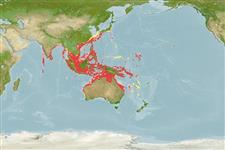Preferred temperature (Ref.
115969): 24.6 - 29, mean 28 (based on 1680 cells).
Phylogenetic diversity index (Ref.
82804): PD
50 = 0.7500 [Uniqueness, from 0.5 = low to 2.0 = high].
Bayesian length-weight: a=0.01820 (0.00693 - 0.04780), b=3.04 (2.81 - 3.27), in cm Total Length, based on LWR estimates for this (Sub)family-body shape (Ref.
93245).
Trophic level (Ref.
69278): 4.0 ±0.65 se; based on food items.
Fishing Vulnerability (Ref.
59153): Low vulnerability (15 of 100).
